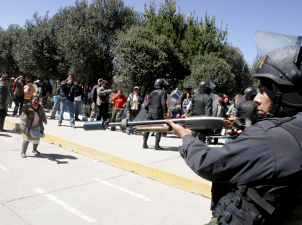
by Joan Martinez-Alier
Glencore-Xstrata causes many socio-environmental conflicts around the world. A well-known case to EJOLT researchers is in Catamarca, Argentina, the copper mine in Bajo la Alumbrera. Another one is in Tintaya, Cusco, Peru. Protesters were killed there some months ago and the mayor of El Espinar was in jail for defending his people and the environment.
No wonder that few are welcoming Glencore-Xstrata to make a copper and gold mine that would sit atop the mountain village of Tablu in Tampakan, South Cotabato, 50 km to the north of the city of General Santos in Mindanao. The mine belongs to Glencore-Xstrata, and the local Saggitarius Mining Investments (SMI).
This large project (with estimated final investment of 5.9 billion USD) has been stopped or drastically downsized in 2013 because of opposition from local government, the Church and local indigenous peoples (the B’laan). There has also been armed resistance.
In 2010 it was estimated that the project would dig up 2.9 billion tones of materials at 0.51% copper and at 0.2g/t gold (at a 0.2% copper cut-off). This represents contained copper of 15 million tonnes and contained gold of almost 18 million ounces. The Tampakan deposit represents the largest copper-gold deposit in the South East Asia – Western Pacific Region after Grassberg, the infamous or at least very controversial mine belonging to Freeport McMoran in Western Papua.
According to the company, the remaining pending issues are the obstacle provided by the open pit mining ban imposed by provincial government and the resettlement of the communities that would receive direct impact from the mining activities. There has also been a national moratorium on mining imposed by the national government of Benigno Aquino. The local Catholic Church headed by Bishop Dinualdo Gutierrez is against the project saying that its operations will only escalate resistance from indigenous people and increased activities from armed rebels in the area.
The New People’s Army has launched attacks against the mining company. On New Year’s Day in 2008, a company of NPA rebels raided and torched the main base camp of SMI.
In addition, several B’laan tribal leaders were reported to have taken up arms over SMI encroachment of their ancestral lands. In 2012 B’laan tribal leader Daguil Capion’s (also spelt Cafeon) unarmed wife and children were killed by the Philippine military. The killing was linked to his opposition to Xstrata’s Tampakan mine. Later his brother was shot dead. This signals a tragic escalation in the conflict given the deployment of Task Force Kitaco, a special unit created to suppress this opposition. This incident followed on a setback for the company, when the Provincial Board of South Cotabato reiterated a previous resolution that confirms the ban on open pit mining in the province.
The downsizing of the mining operation in 2013 perhaps announces a stop to the project.
In EJOLT we need more information from reliable sources drawing on “activist knowledge” on the many environmental conflicts in the Philippines. We shall also make one specific map with information on Glencore-Xstrata’s conflicts around the world in our Atlas of Environmental Conflicts, as we shall do for other companies.

The project ENVJUSTICE has received funding from the European Research Council (ERC) under the European Union’s Horizon 2020 research and innovation programme (grant agreement No. 695446)